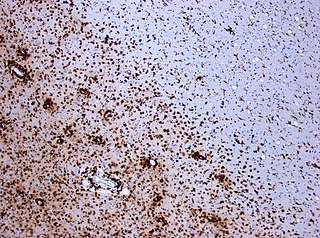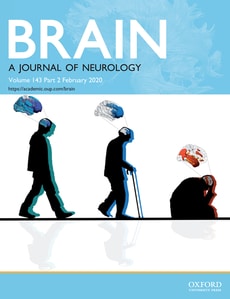Angela Vincent is Emeritus professor at the University of Oxford and a Fellow of Somerville College, Oxford.

Neurology is the branch of medicine dealing with the diagnosis and treatment of all categories of conditions and disease involving the nervous system, which comprises the brain, the spinal cord and the peripheral nerves. Neurological practice relies heavily on the field of neuroscience, the scientific study of the nervous system.

Multiplesclerosis (MS) is the most common demyelinating disease, in which the insulating covers of nerve cells in the brain and spinal cord are damaged. This damage disrupts the ability of parts of the nervous system to transmit signals, resulting in a range of signs and symptoms, including physical, mental, and sometimes psychiatric problems. Specific symptoms can include double vision, visual loss, muscle weakness, and trouble with sensation or coordination. MS takes several forms, with new symptoms either occurring in isolated attacks or building up over time. In the relapsing forms of MS, between attacks, symptoms may disappear completely, although some permanent neurological problems often remain, especially as the disease advances.
Inflammatory demyelinating diseases (IDDs), sometimes called Idiopathic (IIDDs) due to the unknown etiology of some of them, are a heterogenous group of demyelinating diseases - conditions that cause damage to myelin, the protective sheath of nerve fibers - that occur against the background of an acute or chronic inflammatory process. IDDs share characteristics with and are often grouped together under Multiple Sclerosis. They are sometimes considered different diseases from Multiple Sclerosis, but considered by others to form a spectrum differing only in terms of chronicity, severity, and clinical course.

Brain: A Journal of Neurology is a peer-reviewed scientific journal of neurology, founded in 1878 by John Charles Bucknill, David Ferrier, James Crichton-Browne and John Hughlings Jackson. It is published by Oxford University Press.

John Michael Newsom-Davis was a neurologist who played an important role in the discovery of the causes of, and treatments for, Myasthenia gravis, and of other diseases of the nerve-muscle junction, notably Lambert–Eaton myasthenic syndrome and acquired neuromyotonia. Regarded as "one of the most distinguished clinical neurologists and medical scientists of his generation," he died in a car accident in Adjud, Romania, having visited a neurological clinic in Bucharest earlier the same day.
Richard T. Johnson was a physician and scientist at the Johns Hopkins University School of Medicine. Johnson was a faculty member in the Department of Neurology since its inception in 1969 and was the former head of the department. His research into the effects of viruses on the central nervous system has been published in over 300 scientific articles, and Johnson was both a journal and book editor and the author of an influential textbook, Viral Infections of the Nervous System.
Peter Kynaston "PK" Thomas was a Welsh academic neurologist, author, teacher and administrator. From 1974 to 1991 he was Professor of Neurology at the University of London. He was a fellow of University College London and the Royal Society of Medicine, and was the recipient of the Medal of the Association of British Neurologists. Thomas was, at various times, the president of the Association of British Neurologists, the European Neurological Society, and the Peripheral Nerve Society.

Stephen L. Hauser is a professor of the Department of Neurology at the University of California, San Francisco (UCSF) specializing in immune mechanisms and multiple sclerosis (MS). He has contributed to the establishment of consortia that have identified more than 50 gene variants that contribute to MS risk.
Archibald Douglas McAlpine was a British neurologist who pioneered research into multiple sclerosis. His book Multiple sclerosis, published first time in 1955, has since his death been published with the title McAlpine's Multiple Sclerosis, and has become the standard reference for multiple sclerosis researchers. Dr McAlpine was the first one to suggest mercury poisoning as the probable cause for the Minamata disease.

David A. Hafler is an American neurologist. He is the Edgerly Professor and chairman of the department of Neurology at the Yale School of Medicine. He is known for his work in immunity, genetics, and multiple sclerosis. In 2018 he was elected to the National Academy of Medicine.
(Charles) David Marsden, FRS was a British neurologist who made a significant contribution to the field of movement disorders. He was described as ‘arguably the leading academic neurologist and neuroscientist of his generation in the UK’.
Christopher Edward Dennistoun Shaw MBChB, MD, FRACP, FRCP (Hon), FMedSci, FANA is Professor of Neurology and Neurogenetics at the Institute of Psychiatry, Psychology and Neuroscience, King's College London. He is also Head of the Department of Basic and Clinical Neuroscience, Director of the Maurice Wohl Clinical Neuroscience Institute at King's College London and an Honorary Consultant Neurologist and Neurogeneticist at King's College Hospital. His major research interest is in the genetic, molecular and cellular basis of motor neuron diseases such as amyotrophic lateral sclerosis (ALS).

Dimitri Michael Kullmann is a professor of neurology at the UCL Institute of Neurology, University College London (UCL), and leads the synaptopathies initiative funded by the Wellcome Trust. Kullmann is a member of the Queen Square Institute of Neurology Department of Clinical and Experimental Epilepsy and a consultant neurologist at the National Hospital for Neurology and Neurosurgery.

Stephen George Waxman is an American neurologist and neuroscientist. He served as Chairman of the Department of Neurology at Yale School of Medicine, and Neurologist-in-Chief at Yale-New Haven Hospital from 1986 until 2009. As of 2018, he is the Bridget Flaherty Professor of Neurology, Neurobiology, and Pharmacology at Yale University. He founded the Yale University Neuroscience & Regeneration Research Center in 1988 and is its Director. He previously held faculty positions at Harvard Medical School, MIT, and Stanford Medical School. He is also visiting professor at University College London. He is the editor-in-chief of The Neuroscientist and Neuroscience Letters.
William Ian McDonald was a New Zealand neurologist and academic. Having taught and practiced in New Zealand and the United States, he was Professor of Neurology at the Institute of Neurology of the University of London, England, from 1974 to 1998. He was the world leading authority on multiple sclerosis (MS) in the second half of the twentieth-century: the McDonald criteria used to diagnose MS are named after him. He earned Bachelors of Medical Science at the University of Otago in Dunedin (1955), MBChB with Distinction (1957) and PhD (1962). MBChB is a Bachelor of Medicine and Bachelor of Surgery degrees a degree awarded after 5 years of what is analogous to a combined undergraduate-graduate course of study. Such degrees can be awarded in the U.K. and other countries. McDonald's doctoral thesis work dealt with experimental neuropathy in cats induced by diphtheria toxin. It was conducted at the Department of Physiology under the supervision of Professor Archie McIntyre. He lectured widely both in the United Kingdom and abroad. He received, in 1968, a fellowship of the Royal Australian College of Physicians, in 1972 of the London Royal College of Physicians, in 1989 of the Royal College of Ophthalmologists in 1989, and in 1999 of the Academy of Medical Sciences. Accolades for his work included 15 prizes for multiple sclerosis research, a dozen honorary fellowships, and honorary membership of 10 overseas neurological associations.
William Ritchie Russell CBE FRSE was a 20th-century Scottish neurologist.
David James Burke is an Australian neurologist and clinical neurophysiologist. He has held senior positions at the Prince of Wales Hospital, University of New South Wales and University of Sydney. He led one of two teams that formed the Prince of Wales Medical Research Institute, which was renamed Neuroscience Research Australia in 2010. His career has included a focus on the role of spinal cord circuits in the control of movement, the excitability of peripheral nerve axons in health and disease, and other areas of clinical neurophysiology.
Prof Clare Fowler CBE is a British physician and academic who created the subspecialty of uro-neurology, a medical field that combines urology and neurology. This work was done at the Institute of Neurology, University College London, where she is an emeritus professor.
Professor Patrick Francis Chinnery, FRCP, FRCPath, FMedSci, is a neurologist, clinician scientist, and Wellcome Trust Principal Research Fellow based in the Medical Research Council Mitochondrial Biology Unit and the University of Cambridge, where he is also Professor of Neurology and Head of the Department of Clinical Neurosciences.








